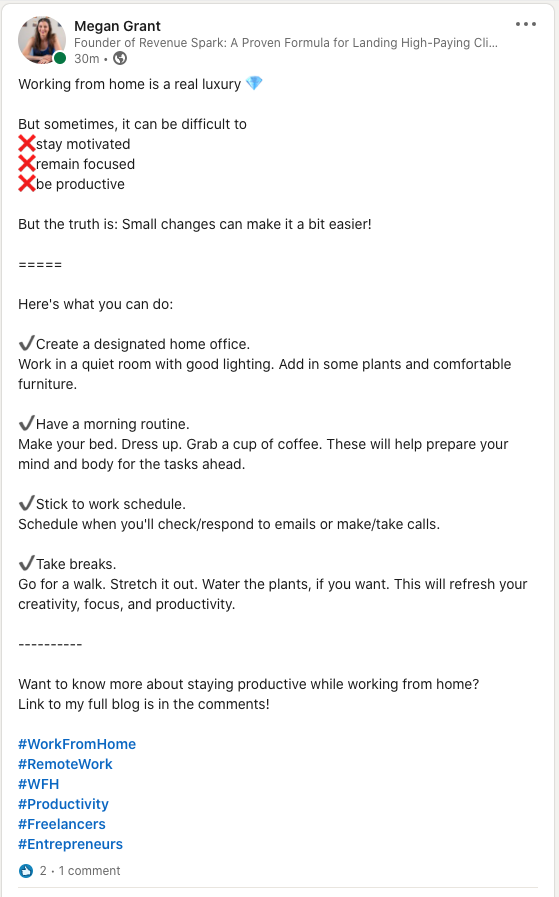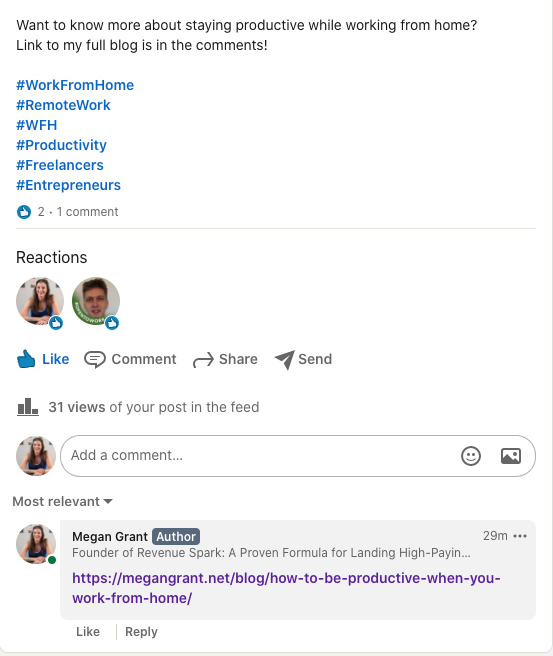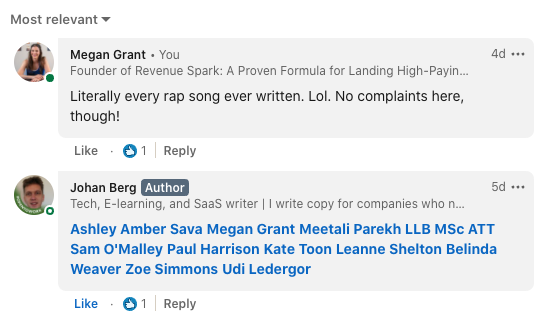Is your LinkedIn engagement underwhelming?
You might have a hard time understanding why you should even bother with the platform if you’re not getting much action on it.
The thing is that throwing up a random post, with no real strategy, and expecting immediate results isn’t really realistic. By the end of this blog post, you’ll have several LinkedIn engagement hacks that you can use to improve the performance and visibility of your page. This means more likes, comments, and shares. More eyeballs on your posts.
Psst! If you prefer video over text, check this out.
I want to be very clear here. The ultimate goal isn’t about vanity metrics. Your post might get 100 likes, but if it isn’t doing anything to actually grow your business, who cares? (Speaking of, don’t forget to check out my mini-course, The 7-Day Secret . I’ll help you target your ideal clients in one week.)
We always want to keep that in mind. LinkedIn is a tool. If you want to learn more specifically about how to use LinkedIn to grow your business, be sure to grab my free guide.
Okay, let’s get going.
4 LinkedIn Engagement Hacks for Better Performance
Hack #1: Prioritize long-form, text-based content.
Let’s talk about what this means.
LinkedIn is a bit unique in that research has found that the best performing content on the platform is text.
This is pretty unusual because more often than not, the best performing content on social media channels is videos.
That’s not the case with LinkedIn. Text-based posts reign supreme.
But it’s about more than posting a quick blurb or a few sentences. You want it to be long-form. Here’s an example of one of my posts:

I’m offering tips for working from home and remaining productive, and I go into more detail. It’s not just the tips themselves. There are short explanations under them, too.
And this is short! Some people will treat their posts almost like mini-blogs, and it’s because that type of content performs well on LinkedIn.
I want to be clear that you should never sacrifice the quality of your post for the sake of making it longer. It won’t matter that it’s long-form if it’s not something people will enjoy reading.
Hack #2: Make the text easy to read.
Let’s go back to this example for a second.

Notice how it’s not just a huge block of text. I split it up into very short paragraphs, and I’ve thrown in a few emojis and lists.
This is really simple: It’s just easier to read.
Now don’t go to town and add in 500 emojis, because then you end up looking spammy. But a few well-placed emojis can add a little life, personality, and color to your post.
Hack #3: Prioritize native content.
I’m going to tell you something that will shock you.
LinkedIn’s absolute favorite thing in the world is… LinkedIn.
It wants to keep people on the platform for as long as possible. So, if you’re posting something that links to a website outside of LinkedIn, therefore sending people away, the platform won’t like that.
On the flipside, if you do what you can to keep people on LinkedIn longer, then the platform will reward you by showing your content to more people.
This is why we stick we native content.
When we say “native,” we mean content that lives on LinkedIn.
Here’s an example. If you post a link to a YouTube video, you’re trying to send people away from LinkedIn to YouTube.
But if you upload that video — the video file — directly to LinkedIn, then you’re putting the actual content directly on the platform. LinkedIn is hosting it. That’s native content.
What sucks about this is it’s essentially saying that you shouldn’t try to use LinkedIn to send traffic to your other pages. But that’s no good. If you’re trying to grow your YouTube page, then you want to send people to YouTube, damnit!
The workaround is to put the link to whatever you want people to see in a comment on your LinkedIn post, not within the body itself.
Going back to my example, this is exactly what I did. That post was actually about content that I share in a blog post I wrote. So, at the end of the LinkedIn post, I’ve got, “The link to my full blog is in the comments,” my hashtags, and then I put the link in a comment.

By the way, I’ve got a whole blog (and video!) specifically on how to use hashtags on LinkedIn.
I am not telling you never to post outside content or link to outside content. But if that’s all you’re doing, trying to send people to another page or platform, your engagement is going to reflect it.
Hack #4: When applicable, tag people who would be interested in what you’re posting.
It’s not called social isolation.
Aren’t we isolated enough right now? #covid
It’s called social networking, and for a reason. You’re supposed to interact with other people. And the title of this blog is LinkedIn ENGAGEMENT hacks. Engagement means other people are involved.
Don’t go and spam the crap out of your post by tagging 50 different people. Pick one or two people, weave them into the post somehow, and tag them!
You could also use a comment to tag a few people who you think might be interested in your post, and invite them to participate in the conversation.
One of my students in Revenue Spark, Johan, he does this. He’ll tag people in a comment who he knows will be interested in it, and we get the notification. I go to the post, read it, and I’m like, “Oh yeah, I dig this.” And I’ll comment.

He’s very intentional about it. Not spammy. Be like Johan.
I use LinkedIn almost on a daily basis to grow my business. It delivers real, measurable results. That’s why it’s part of what I teach in my program, Revenue Spark. If you need help landing your next client, and you’re wondering if the program is right for you, book a call and we’ll talk more.